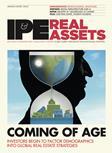Right on time

Is now the time to embrace property derivatives? Some fund managers avoided the worst of the downturn by hedging the downside risk at the right time. Charles Ostroumoff explains how investors could profit from derivatives in the current market cycle
This content is only available IPE Real Asset members
Already an IPE Real Assets Member? Sign in here
Unlock your IPE Real Assets Membership Package
For access to IPE Real Assets industry-leading market intelligence the leading information resource for the European institutional real assets investment community.
PropertyEU has now merged with IPE Real Assets
Membership will give you full access to the PropertyEU archive.
If you have a PropertyEU membership find out how to get access.
IPE Real Assets Membership
IPE Real Assets has created a suite of products and services for Europe’s institutional real estate investment community.
country analysis and data
and strategies in depth

IPE covers a good variety of very current and relevant topics. It is good to read the high-level, independent and objective perspectives from pension funds in other European countries; many of them are dealing with the same issues as we are, so it is interesting to learn from their experiences, especially when they are ahead of where we are on the curve.






